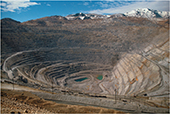issues in Science: Human Impact on the Environment
Many natural processes, including weathering and erosion, change the shape of the landscape. But there is another powerful agent of geologic change—people! The activities of humans have a great impact on the natural forces that shape Earth's surface. For example, acid rain caused by air pollution increases erosion rates. Humans also change the course of rivers, which can affect natural flooding patterns.
People also shape the land directly through mining and construction. For example, about 12,000 kilograms of minerals are removed from the ground each year for each person in the United States. We also dig up the land to make room for new homes, carve up the land with roads, and pave it over with parking lots. In fact, the amount of land in the U.S. that is covered with roads and parking lots is larger than the size of the state of Georgia; the amount of land developed into towns and cities is larger than the size of the state of California.

The Viewpoints
Reduce Human Activites
Proponents of reducing human activities that impact the land argue that humans have shaped the lands to their own needs, sometimes with extreme consequences. More than a third of land surface on Earth not covered with ice is now used to raise or grow food for people. We continue to change forests to fields and wetlands to housing developments.
Humans are now altering the land surface faster than any other natural process. The human population has doubled in the time since we landed space probes on the moon. Unless human activities are reduced, the surface of the earth will soon bear no resemblance to the lands of our ancestors. We need to reduce the impacts on the land before the damage can't be reversed.
Human Activities Are “Natural”
Throughout geologic history, the surfaces of the land have changed drastically, sometimes catastrophically. Proponents of continuing humans activities unabated point out that these activities are similar to the geologic processes that have greatly altered Earth's surface. Humans are part of nature too.
Earth, as we know it, is not the way it has always been. During the last Ice Age, 15,000 years ago, much of North America was covered with thick ice. Rising sea levels during warm periods flooded regions of the continents with shallow oceans. The rate of human change to the land is fast, but not as fast as that of volcanic eruptions and asteroid impacts that have changed Earth. The impact of human activity is only a small part of the natural processes that change the land.
Research and Decide
Defining the Issue In your own words, explain the major issues involved in whether or not humans should reduce the impacts they have on the land.
Analyzing the Viewpoints What risks to the land are posed by human activities? What are the benefits to the land?
Forming Your Opinion Should there be laws to reduce human changes to the land? What criteria would you use to make such decisions? Give reasons for your opinions.
Persuasive Writing Choose one way that humans are changing the land. Suppose your state's senator is going to vote on this issue in Congress. Write a letter to your senator presenting your position on this issue.





